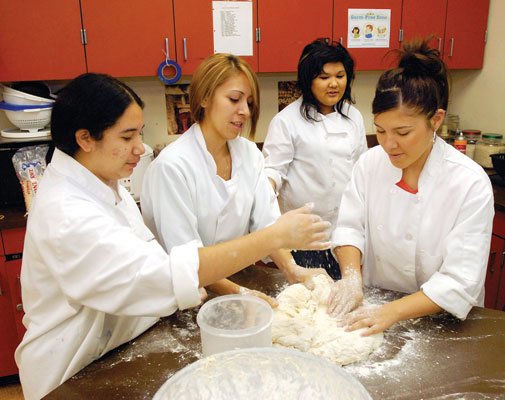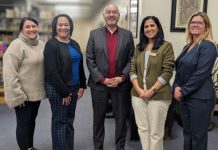Old school vocational education classes like woodworking and
auto shop haven’t gone away, but a fresh spin on an old idea is
exposing high school students to medicine, agriculture and criminal
justice long before they leave the classroom and head out into the
world.
Also with this story, a video of photo gallery.
Old school vocational education classes like woodworking and auto shop haven’t gone away, but a fresh spin on an old idea is exposing high school students to medicine, agriculture and criminal justice long before they leave the classroom and head out into the world.
Recent numbers released by the California Department of Education show that 21.5 percent of students drop out of school. At Gilroy High School, 18.4 percent of students don’t make it to graduation, according to the state’s formula; school administrators and trustees alike agreed that one lost student is one too many and use words like “relevant,” “engaging” and “challenging” to describe the classes needed to keep students in school.
A study conducted by the Bill and Melinda Gates Foundation surveyed those at the heart of the problem: the high school dropouts themselves. Of the 500 dropouts interviewed, nearly half said classes weren’t interesting and about seven in 10 said they could have graduated if they had tried, they weren’t motivated and they would have worked harder if more had been expected of them.
Four in five dropouts said more “real-world” experience would have kept them in school.
“It helps me stay in school,” said Albert Kay, a 10th grader at GHS, of his automotive class.
Kay doesn’t like school and, given the option, wouldn’t go most days if not for his shop class.
“I didn’t come a lot last year because there was nothing to look forward to,” he said. “But I come now because I want to be a mechanic.”
While Kay can’t relate to classroom lectures and seatwork, using his hands and spinning wrenches as a mechanic comes naturally and he’s working toward his certification in brakes and cooling systems.
The effort to boost standardized test scores nudged vocational education to the back burner for years, but recent studies have brought the hands-on, real-world classes back to the fore.
As part of the Santa Clara County Regional Occupational Program, students can sign up for a number of career oriented courses at GHS including animation and digital design, food services, marketing, sports medicine, veterinary science and others. In fact, they’re required to take at least one of the 15 ROP courses offered at GHS to graduate. About 500 students are enrolled in ROP classes this semester, GHS Vice Principal Stefani Garino said. The program receives about $700,000 annually from the state to pay for teacher salaries and supplies, which can get very expensive for classes like food services and sports medicine. And about 80 seniors are enrolled in a program called work experience that gives them a chance to learn skills like interviewing techniques and resume writing.
Garino is in the process of writing a five-year plan for GHS, Christopher High School – which is slated to open in August 2009 – and the middle schools that reflects the district’s vision to implement more career oriented curriculum.
“It takes a lot of planning,” Garino said, “and we’re not quite there yet.”
She and her colleagues are working on designing curriculum that will introduce students to career paths that are relevant to today’s job market. Plans are already in place to begin a biotechnology academy at GHS and a performing arts and digital media program at CHS.
“You don’t just throw programs out to kids that are glamorous. We have to be realistic,” she said, naming career paths like agriculture and biotechnology. “We have to think about what courses are going to feed these students back into the community.”
She’s hoping to introduce strands of programs, starting at the middle school level, to allow students to learn the basic skills and knowledge of a woodshop or cooking class. Ideally, they would get a taste in middle school and build on their skills throughout high school so they have a purpose to work toward, graduating with a diploma, plus some real-world skills. Currently, students walk away from ROP with a certificate they can take to an employer showing their competency and/or certifications, said David Matuszak, director of the South County ROP. Teachers also help students with placements and act as references. More developed pathways would add to the list of skills students can present to a potential employer.
CHS Principal John Perales’ goal for the program is to have every student graduate with a certification in their specialty area so that they can have the choice to either pursue a post-secondary education or head to work with strong, marketable skills.
“My vision for kids is that we do everything in our power to prepare them for college,” he said. “But I know there are other paths. I’m passionate about kids going to college but I know we need to meet their needs and sometimes that’s not the college road. We have to look at kids’ strengths and support them in that area.”
Like Perales, many district officials recognize that a “one size fits all” mentality is unrealistic and outdated.
“Though I want to provide equal opportunities for all students to pursue post-secondary education and increase the acceptance rate of Gilroy students to four-year colleges, I also recognize that not all students are the same nor can they be put in the same box,” said School Board President Rhoda Bress. “If we want to provide different options for students, then the current career and technical training program in our district will need to expand, and this will require a significant infusion of additional resources.”
Bress added that the program is not yet geared to meet the needs of students headed straight to the workforce after high school.
“For the students at risk of dropping out of school, the current ROP structure is not adequate,” she said.
Well-articulated internships and post-secondary work placements are long-term goals that bring in scholarships and grants, Garino said, but like Bress said, the ever-present problems are money and organization.
Each school only receives a certain amount of money from the state for ROP courses before funds are capped, Matuszak said. Coordinating with multiple schools often doesn’t work because of conflicting schedules and after-school offerings are minimal because of financial constraints.
“More money is a dream right now,” Garino said.
Although there are no hard numbers pinpointing the percentage of potential dropouts saved by ROP, the attraction of ROP programs for students at risk of dropping out is undeniable, she said, hoping that a well-organized game plan might generate additional state dollars.
“We’d be doing a disservice to kids by not introducing them to what’s out there in the real world,” she said.













